From Wikipedia, the free encyclopedia
| Killer whale[1] | |
|---|---|
 |
|
| Transient killer whales near Unimak Island, eastern Aleutian Islands, Alaska | |
 |
|
| Size comparison to an average human | |
| Conservation status | |
| Scientific classification | |
| Kingdom: | Animalia |
| Phylum: | Chordata |
| Class: | Mammalia |
| Order: | Cetacea |
| Suborder: | Odontoceti |
| Family: | Delphinidae |
| Genus: | Orcinus Fitzinger, 1860[3] |
| Species: | O. orca |
| Binomial name | |
| Orcinus orca (Linnaeus, 1758)[4] |
|
 |
|
| Orcinus orca range (in blue) | |
| Synonyms | |
|
Orca gladiator |
|
Killer whales are highly social; some populations are composed of matrilineal family groups which are the most stable of any animal species.[5] Their sophisticated hunting techniques and vocal behaviors, which are often specific to a particular group and passed across generations, have been described as manifestations of culture.[6]
The IUCN currently assesses the orca's conservation status as data deficient because of the likelihood that two or more killer whale types are separate species. Some local populations are considered threatened or endangered due to prey depletion, habitat loss, pollution (by PCBs), capture for marine mammal parks, and conflicts with fisheries. In late 2005, the "southern resident" population of killer whales that inhabits British Columbia and Washington state waters were placed on the U.S. Endangered Species list.
Wild killer whales are not considered a threat to humans,[7] although there have been cases of captives killing or injuring their handlers at marine theme parks.[8] Killer whales feature strongly in the mythologies of indigenous cultures, with their reputation ranging from being the souls of humans to merciless killers.
Contents
Taxonomy and evolution
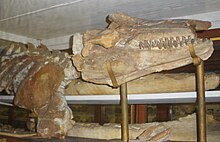
Orcinus citoniensis fossil, an extinct species of the same genus, Museo Capellini di Bologna
The killer whale is one of 35 species in the oceanic dolphin family, which first appeared about 11 million years ago. The killer whale lineage probably branched off shortly thereafter.[7] Although it has morphological similarities with the pygmy killer whale, the false killer whale and the pilot whales, a study of cytochrome b gene sequences by Richard LeDuc indicated that its closest extant relatives are the snubfin dolphins of the genus Orcaella.[11]
Common names
English-speaking scientists most often use the term "killer whale",[12] although the term "orca" is increasingly used. Killer whale advocates point out it has a long heritage. Indeed, the genus name Orcinus means "of the kingdom of the dead",[12] or "belonging to Orcus".[13] Ancient Romans originally applied orca (plural orcae) to these animals, possibly borrowing it from the Greek ὄρυξ, which referred (among other things) to a whale species. Since the 1960s, orca has steadily grown in popularity; both names are now used. The term orca is preferred by some to avoid the negative connotations of "killer",[14] and because, being part of the family Delphinidae, the species is more closely related to other dolphins than to whales.[15]They are sometimes referred to as blackfish, a name used for some whale species, as well. Grampus is a former name for the species, but is now seldom used. This meaning of grampus should not be confused with the Grampus genus, whose only member is Risso's dolphin.[16]
Types
The three to five types of killer whales may be distinct enough to be considered different races,[17] subspecies, or possibly even species.[18] The IUCN reported in 2008, "The taxonomy of this genus is clearly in need of review, and it is likely that O. orca will be split into a number of different species or at least subspecies over the next few years."[2] In the 1970s and 1980s, research off the west coast of Canada and the United States identified the following three types:- Resident: These are the most commonly sighted of the three populations in the coastal waters of the northeast Pacific. Residents' diets consist primarily of fish[19] and sometimes squid, and they live in complex and cohesive family groups called pods.[20] Female residents characteristically have rounded dorsal fin tips that terminate in a sharp corner.[21] They visit the same areas consistently. British Columbia and Washington resident populations are amongst the most intensively studied marine mammals. Researchers have identified and named over 300 killer whales over the past 30 years.[22]
- Transient: The diets of these whales consist almost exclusively of marine mammals.[19][21] Transients generally travel in small groups, usually of two to six animals, and have less persistent family bonds than residents.[23] Transients vocalize in less variable and less complex dialects.[24] Female transients are characterized by more triangular and pointed dorsal fins than those of residents.[21] The gray or white area around the dorsal fin, known as the "saddle patch", often contains some black colouring in residents. However, the saddle patches of transients are solid and uniformly gray.[21] Transients roam widely along the coast; some individuals have been sighted in both southern Alaska and California.[25] Transients are also referred to as Bigg's killer whale in honor of Michael Bigg. The term has become increasingly common and may eventually replace the transient label.[26]
- Offshore: A third population of killer whales in the northeast Pacific was discovered in 1988, when a humpback whale researcher observed them in open water. As their name suggests, they travel far from shore and feed primarily on schooling fish.[27] However, because they have large, scarred and nicked dorsal fins resembling those of mammal-hunting transients, it may be that they also eat mammals and sharks.[28][29] They have mostly been encountered off the west coast of Vancouver Island and near the Queen Charlotte Islands. Offshores typically congregate in groups of 20–75, with occasional sightings of larger groups of up to 200.[30] Currently, little is known about their habits, but they are genetically distinct from residents and transients. Offshores appear to be smaller than the others, and females are characterized by dorsal fin tips that are continuously rounded.[21]
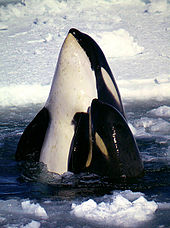
Type C killer whales in the Ross Sea: The eye patch slants forward.
Other populations have not been as well studied, although specialized fish-eating and mammal-eating killer whales have been distinguished elsewhere.[36] Separate populations of fish-eating and mammal-eating killer whales have been identified around the United Kingdom.[37][38] Fish-eating killer whales in Alaska[39] and Norway[40] have resident-like social structures, while mammal-eating killer whales in Argentina and the Crozet Islands behave more like transients.[41]
Three types have been documented in the Antarctic. Two dwarf species, named Orcinus nanus and Orcinus glacialis, were described during the 1980s by Soviet researchers, but most cetacean researchers are skeptical about their status, and linking these directly to the types described below is difficult.[18]
- Type A looks like a "typical" killer whale, a large, black and white form with a medium-sized white eye patch, living in open water and feeding mostly on minke whales.[18]
- Type B is smaller than type A. It has a large white eye patch. Most of the dark parts of its body are medium gray instead of black, although it has a dark gray patch called a "dorsal cape"[42] stretching back from its forehead to just behind its dorsal fin. The white areas are stained slightly yellow. It feeds mostly on seals.[18]
- Type C is the smallest type and lives in larger groups than the others. Its eye patch is distinctively slanted forwards, rather than parallel to the body axis. Like type B, it is primarily white and medium gray, with a dark gray dorsal cape and yellow-tinged patches. Its only observed prey is the Antarctic cod.[18]
- Type D was identified based on photographs of a 1955 mass stranding in New Zealand and six at-sea sightings since 2004. It is immediately recognizable by its extremely small white eye patch, shorter than usual dorsal fin, and bulbous head (similar to a pilot whale). Its geographic range appears to be circumglobal in subantarctic waters between latitudes 40°S and 60°S. And although nothing is known about the type D diet, it is suspected to include fish because groups have been photographed around longline vessels where they reportedly prey on Patagonian toothfish (Dissostichus eleginoides).[43][44]
Research is ongoing into the genetic relationships among killer whale types, and whether these types represent deep evolutionary trends. For example, mammal-eating killer whales were long thought likely to be closely related to other mammal-eating killer whales from different regions, but genetic testing refuted this hypothesis.[48]
Morphology
A typical killer whale distinctively bears a black back, white chest and sides, and a white patch above and behind the eye. Calves are born with a yellowish or orange tint, which fades to white. It has a heavy and robust body[49] with a large dorsal fin up to 2 m (6.6 ft) tall. Behind the fin, it has a dark grey "saddle patch" across the back. Antarctic killer whales may have pale grey to nearly white backs. Adult killer whales are very distinctive and are not usually confused with any other sea creature.[50] When seen from a distance, juveniles can be confused with other cetacean species, such as the false killer whale or Risso's dolphin.[51] The killer whale's teeth are very strong and covered in enamel. Its jaws are a powerful gripping apparatus, as the upper teeth fall into the gaps between the lower teeth when the mouth is closed. The front teeth are inclined slightly forward and outward, thus allowing the killer whale to withstand powerful jerking movements from its prey while the middle and back teeth hold it firmly in place.[52]Killer whales are the largest extant members of the dolphin family. Males typically range from 6 to 8 metres (20 to 26 ft) long and weigh in excess of 6 tonnes (5.9 long tons; 6.6 short tons).[53] Females are smaller, generally ranging from 5 to 7 m (16 to 23 ft) and weighing about 3 to 4 tonnes (3.0 to 3.9 long tons; 3.3 to 4.4 short tons).[53] The largest male killer whale on record was 9.8 m (32 ft), weighing over 10 tonnes (9.8 long tons; 11 short tons), while the largest female was 8.5 m (28 ft), weighing 7.5 tonnes (7.4 long tons; 8.3 short tons).[54] Calves at birth weigh about 180 kg (400 lb) and are about 2.4 m (7.9 ft) long.[55][56] The killer whale's large size and strength make it among the fastest marine mammals, able to reach speeds in excess of 30 knots (56 km/h).[57] The skeleton of the killer whale is of the typical delphinid structure, but is more robust.[58] Its integument, unlike that of most other dolphin species, is characterised by a well-developed dermal layer with a dense network of fascicles of collagen fibers.[59]
Killer whale pectoral fins are large and rounded, resembling paddles. Males have significantly larger pectoral fins than females. At about 1.8 m (5.9 ft) the male's dorsal fin is more than twice the size of the female's and is more of a triangular shape—a tall, elongated isosceles triangle—whereas hers is shorter and more curved.[60] Males and females also have different patterns of black and white skin in their genital areas.[61] Sexual dimorphism is also apparent in the skull; adult males have longer lower jaws than females, and have larger occipital crests.[59]
An individual killer whale can often be identified from its dorsal fin and saddle patch. Variations such as nicks, scratches, and tears on the dorsal fin and the pattern of white or grey in the saddle patch are unique. Published directories contain identifying photographs and names for hundreds of North Pacific animals. Photographic identification has enabled the local population of killer whales to be counted each year rather than estimated, and has enabled great insight into lifecycles and social structures.[62]
White killer whales occur sporadically but rarely among normal killer whales; they have been spotted in the northern Bering Sea and around St. Lawrence Island, and near the Russian coast.[30][63] In February 2008, a white killer whale was photographed 2 mi (3.2 km) off Kanaga Volcano in the Aleutian Islands.[30][63]
Killer whales have good eyesight above and below the water, excellent hearing, and a good sense of touch. They have exceptionally sophisticated echolocation abilities, detecting the location and characteristics of prey and other objects in their environments by emitting clicks and listening for echoes.[64]
The mean body temperature of the orca is 36.0 to 38°C.[65][66] Like most marine mammals, orcas have a layer of insulating blubber (7.6 to 10 cm thick[65]) beneath its skin.
The heart beats at a rate of about 60 beats/min when the orca is at the surface, dropping to 30 beats/min when submerged.[67]
Life cycle
Females breed until age 40, meaning on average they raise five offspring. The lifespans of wild females average 50 years, with a maximum of 80–90 years.[71] Males sexually mature at the age of 15, but do not typically reproduce until age 21. Wild males live around 29 years on average, with a maximum of 50–60 years.[71] One male, known as Old Tom, was reportedly spotted every winter between the 1840s and 1930 off New South Wales, Australia. This would have made him up to 90 years old. Examination of his teeth indicated he died around age 35,[72] but this method of age determination is now believed to be inaccurate for older animals.[73] One male known to researchers in the Pacific Northwest (identified as J1) was estimated to have been 59 years old when he died in 2010.[74] Captive killer whale lifespans are typically significantly shorter, usually less than 25 years; however, numerous individuals are alive in their 30s, and a few have reached their 40s.[75][76]
Range and habitat
Killer whales are found in all oceans and most seas. Due to their enormous range, numbers, and density, distributional estimates are difficult to compare,[77] but they clearly prefer higher latitudes and coastal areas over pelagic environments.[78]Systematic surveys indicate the highest densities of killer whales (>0.40 individuals per 100 km²) in the northeast Atlantic around the Norwegian coast, in the north Pacific along the Aleutian Islands, the Gulf of Alaska and in the Southern Ocean off much of the coast of Antarctica.[77] They are considered "common" (0.20–0.40 individuals per 100 km²) in the eastern Pacific along the coasts of British Columbia, Washington and Oregon, in the North Atlantic Ocean around Iceland and the Faroe Islands. High densities have also been reported but not quantified in the western North Pacific around the Sea of Japan, Sea of Okhotsk, Kuril Islands, Kamchatka and the Commander Islands and in the Southern Hemisphere off the coasts of South Australia, Patagonia, off the coast of southern Brazil and the tip of southern Africa. They are reported as seasonally common in the Canadian Arctic, including Baffin Bay between Greenland and Nunavut, and around Tasmania and Macquarie Island.[77] Information for offshore regions and tropical waters is more scarce, but widespread, if not frequent, sightings indicate the killer whale can survive in most water temperatures. They have been sighted, for example, in the Mediterranean, the Arabian Sea, the Gulf of Mexico and the Indian Ocean around the Seychelles.[77]
Probably the largest population lives in Antarctic waters, where they range up to the edge of the pack ice and are believed to venture into the denser pack ice, finding open leads much like beluga whales in the Arctic. In contrast, killer whales are seasonal summer visitors to Arctic waters, where they do not approach the ice pack. With the rapid Arctic sea ice decline in the Hudson Strait, their range now extends deep into the northwest Atlantic.[79]
Migration patterns are poorly understood. Each summer, the same individuals appear off the coasts of British Columbia and Washington. Despite decades of research, where these animals go for the rest of the year remains unknown. Transient pods have been sighted from southern Alaska to central California.[80] Resident killer whales sometimes travel as much as 160 km (100 mi) in a day, but may be seen in a general area for a month or more. Resident killer whale pod ranges vary from 320 to 1,300 kilometres (200 to 810 mi).
Occasionally, killer whales swim into freshwater rivers. They have been documented 100 mi (160 km) up the Columbia River in the United States.[81][82] They have also been found in the Fraser River in Canada and the Horikawa River in Japan.[81]
Population
Worldwide population estimates are uncertain, but recent consensus suggests an absolute minimum of 50,000.[2][30] Local estimates include roughly 25,000 in the Antarctic, 8,500 in the tropical Pacific, 2,250–2,700 off the cooler northeast Pacific and 500–1,500 off Norway.[83] Japan's Fisheries Agency estimated 2,321 killer whales were in the seas around Japan.[84][85]Feeding
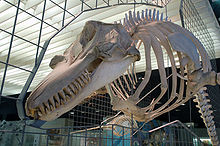
A killer whale skeleton
Killer whales are apex predators, meaning that they themselves have no natural predators. They are sometimes called the wolves of the sea, because they hunt in groups like wolf packs.[90]
Fish, reptiles and invertebrates
Fish-eating killer whales prey on around 30 species of fish, particularly salmon, herring, and tuna. In New Zealand, rays are killer whales' most frequent prey,[91] and they have also been observed hunting sharks (particularly makos, threshers and smooth hammerheads). Squid and sea turtles are also taken.[92]While salmon are usually hunted by an individual or a small group of individuals, herring are often caught using carousel feeding; the killer whales force the herring into a tight ball by releasing bursts of bubbles or flashing their white undersides. They then slap the ball with their tail flukes, either stunning or killing up to 10–15 fish at a time. The herring are then eaten one at a time. Carousel feeding has only been documented in the Norwegian killer whale population and with some oceanic dolphin species.[93]
Killer whales can induce tonic immobility in sharks and rays by holding them upside down, rendering them helpless and incapable of injuring the whale. Some sharks suffocate within about 15 minutes while the whale holds them still, because these sharks need to move to breathe. In one incident filmed near the Farallon Islands in October 1997, a female killed a 3–4-metre (9.8–13 ft) long great white shark,[94] apparently after swimming with it upside-down in her mouth and inducing tonic immobility in it. She and another pod member ate the shark's liver and allowed the rest of the carcass to sink.[95]
In July 1992, two killer whales attacked, killed and fed on an 8-metre (26 ft) long whale shark, Rhincodon typus, in the waters off Bahia de los Angeles in Baja California.[96]
Mammal prey
Killer whales are very sophisticated and effective predators. Thirty-two cetacean species have been recorded as killer whale prey, from examining either stomach contents, scarring on the prey's body, or feeding activity. Groups even attack larger cetaceans such as minke whales, gray whales, and rarely sperm whales or blue whales.[36][97][98][99]Hunting large whales usually takes several hours. Killer whales generally choose to attack young or weak animals, instead. However, a group of five or more may attack a healthy adult. When hunting a young whale, a group chases it and its mother until they wear out. Eventually, they separate the pair and surround the calf, preventing it from surfacing to breathe, drowning it. Pods of female sperm whales sometimes protect themselves by forming a protective circle around their calves with their flukes facing outwards, using them to repel the attackers.[100] Rarely, large killer whale pods can overwhelm even adult female sperm whales. Adult bull sperm whales, which are large, powerful and aggressive when threatened, and fully grown adult blue whales, which are possibly too large to overwhelm, are not believed to be prey for killer whales.[101]
Other marine mammal prey species include nearly 20 species of seal, sea lion and fur seal. Walruses and sea otters are less frequently taken. Often, to avoid injury, killer whales disable their prey before killing and eating it. This may involve throwing it in the air, slapping it with their tails, ramming it, or breaching and landing on it.[102] Sea lions are killed by head-butting or after a stunning blow from a tail fluke. In the Aleutian Islands, a decline in sea otter populations in the 1990s was controversially attributed by some scientists to killer whale predation, although with no direct evidence.[103] The decline of sea otters followed a decline in harbour seal and Steller sea lion populations, the killer whale's preferred prey,[Note 1][105] which in turn may be substitutes for their original prey, now decimated by industrial whaling.[106][107][108]
In steeply banked beaches off Península Valdés, Argentina, and the Crozet Islands, killer whales feed on South American sea lions and southern elephant seals in shallow water, even beaching temporarily to grab prey before wriggling back to the sea. Beaching, usually fatal to cetaceans, is not an instinctive behavior, and can require years of practice for the young.[109] "Wave-hunting" killer whales spy-hop to locate Weddell seals, crabeater seals and leopard seals resting on ice floes, and then swim in groups to create waves that wash over the floe. This washes the seal into the water, where other killer whales lie in wait.[110][111]
Killer whales have also been observed preying on terrestrial mammals, such as deer and moose swimming between islands off the northwest coast of North America.[104] Killer whale cannibalism has also been reported based on analysis of stomach contents, but this is likely to be the result of scavenging remains dumped by whalers.[112] One killer whale was also attacked by its companions after being shot.[36] Although resident killer whales have never been observed to eat other marine mammals, they occasionally harass and kill porpoises and seals for no apparent reason.[113]
Birds
Killer whales in many areas prey on several bird species, including penguins, cormorants and gulls.[114] A captive killer whale at MarineLand discovered it could regurgitate fish onto the surface, attracting sea gulls, and then eat the birds. Four others then learned to copy the behavior.[115]Behavior
Day-to-day killer whale behavior generally consists of foraging, travelling, resting and socializing. Killer whales are frequently active at the surface, engaging in acrobatic behaviors such as breaching, spyhopping, and tail-slapping. These activities may have a variety of purposes, such as courtship, communication, dislodging parasites, or play. Spyhopping, a behaviour in which a whale holds its head above water, helps the animal view its surroundings.[116]Resident killer whales swim with porpoises, other dolphins, seals, and sea lions, which are common prey for transient killer whales.
Social structure
Killer whales are notable for their complex societies. Only elephants and higher primates, such as humans, live in comparably complex social structures.[69] Due to orcas' complex social bonds and society, many marine experts have concerns about how humane it is to keep these animals in captive situations.[117] Resident killer whales in the eastern North Pacific have a particularly complex and stable social grouping system. Unlike any other mammal species whose social structure is known, residents live with their mothers for their entire lives. These societies are based on matrilines consisting of the matriarch and her descendants which form part of the line, as do their descendants. The average size of a matriline is 5.5 animals.[118]Because females can reach age 90, as many as four generations travel together. These matrilineal groups are highly stable. Individuals separate for only a few hours at a time, to mate or forage. With one exception, the killer whale named Luna, no permanent separation of an individual from a resident matriline has been recorded.[118]
Closely related matrilines form loose aggregations called pods, usually consisting of one to four matrilines. Unlike matrilines, pods may separate for weeks or months at a time.[118] DNA testing indicates resident males nearly always mate with females from other pods.[119]

Killer whales, like this one spotted near Alaska, commonly breach, often lifting their entire bodies out of the water.
The final association layer, perhaps more arbitrarily defined than the familial groupings, is called the community, and is defined as a set of clans that regularly commingle. Clans within a community do not share vocal patterns.[Note 2]
Transient pods are smaller than resident pods, typically consisting of an adult female and one or two of her offspring. Males typically maintain stronger relationships with their mothers than other females. These bonds can extend well into adulthood. Unlike residents, extended or permanent separation of transient offspring from natal matrilines is common, with juveniles and adults of both sexes participating. Some males become "rovers" and do not form long-term associations, occasionally joining groups that contain reproductive females.[120] As in resident clans, transient community members share an acoustic repertoire, although regional differences in vocalizations have been noted.[121]
Vocalizations
| Multimedia relating to the orca | ||||
|
||||
See also: Whale sound
Like all cetaceans,
killer whales depend heavily on underwater sound for orientation,
feeding, and communication. They produce three categories of sounds:
clicks, whistles, and pulsed calls. Clicks are believed to be used
primarily for navigation and discriminating prey and other objects in
the surrounding environment, but are also commonly heard during social
interactions.[30]Northeast Pacific resident groups tend to be much more vocal than transient groups in the same waters.[122] Residents feed primarily on Chinook and chum salmon, species that are insensitive to killer whale calls (inferred from the audiogram of Atlantic salmon). In contrast, the marine mammal prey of transients hear well underwater at the frequencies used in killer whale calls.
Transients are typically silent, probably to avoid alerting their mammalian prey.[122] They sometimes use a single click (called a cryptic click) rather than the long train of clicks observed in other populations. Residents are only silent when resting.
All members of a resident pod use similar calls, known collectively as a dialect. Dialects are composed of specific numbers and types of discrete, repetitive calls. They are complex and stable over time. Call patterns and structure are distinctive within matrilines. Newborns produce calls similar to their mothers, but have a more limited repertoire.[121] Individuals likely learn their dialect through contact with their mother and other pod members.[123] For instance, family-specific calls have been observed more frequently in the days following a calf's birth, which may help the calf learn them.[124] Dialects are probably an important means of maintaining group identity and cohesiveness. Similarity in dialects likely reflects the degree of relatedness between pods, with variation building over time.[125]
Researchers have not determined whether calls have particular meanings or are associated with specific types of activity. Resident dialects contain seven to 17 (mean = 11) distinctive call types. Transient dialects are much different, having only four to six discrete calls, none of which they share with residents. All members of the North American west coast transient community express the same basic dialect, although minor regional variation in call types is evident. Preliminary research indicates offshore killer whales have group-specific dialects unlike those of residents and transients.[125]
Intelligence
Main article: Cetacean intelligence
Killer whales have the second-heaviest brains among marine mammals[126] (after Sperm whales, which have the largest brain of any animal). They can be trained in captivity and are often described as intelligent,[127][128]
although defining and measuring "intelligence" is difficult in a
species whose environment and behavioral strategies are very different
from those of humans.[128]People who have interacted closely with killer whales offer numerous anecdotes demonstrating the whales' curiosity, playfulness, and ability to solve problems. For example, Alaskan killer whales have not only learned how to steal fish from longlines, but also have overcome a variety of techniques designed to stop them, such as the use of unbaited lines as decoys.[130] Once, fishermen placed their boats several miles apart, taking turns retrieving small amounts of their catch, in the hope that the whales would not have enough time to move between boats to steal the catch as it was being retrieved. A researcher described what happened next:
In other anecdotes, researchers describe incidents in which wild killer whales playfully tease humans by repeatedly moving objects the humans are trying to reach,[131] or suddenly start to toss around a chunk of ice after a human throws a snowball.[132]"It worked really well for a while. Then the whales split into two groups. It didn't even take them an hour to figure it out. They were so thrilled when they figured out what was going on, that we were playing games. They were breaching by the boats."—Craig Matkin[130]
The killer whale's use of dialects and the passing of other learned behaviours from generation to generation have been described as a form of culture.[133]
"The complex and stable vocal and behavioural cultures of sympatric groups of killer whales (Orcinus orca) appear to have no parallel outside humans and represent an independent evolution of cultural faculties."[6]
Conservation
Like other animals at the highest trophic levels, the killer whale is particularly at risk of poisoning from accumulation of toxins, including polychlorinated biphenyls (PCBs).[134] European harbour seals have problems in reproductive and immune functions associated with high levels of PCBs and related contaminants, and a survey off the Washington coast found PCB levels in killer whales were higher than levels that had caused health problems in harbour seals.[134] Blubber samples in the Norwegian Arctic show higher levels of PCBs, pesticides and brominated flame-retardants than in polar bears. When food is scarce, killer whales metabolize blubber for energy, which increases pollutant concentrations.
In the Pacific Northwest, wild salmon stocks, a main resident food source, have declined dramatically in recent years.[2] On the west coast of Alaska and the Aleutian Islands, seal and sea lion populations have also substantially declined.[135]
In 2005, the United States government listed the southern resident community as an endangered population under the Endangered Species Act.[30] This community comprises three pods which live mostly in the Georgia and Haro Straits and Puget Sound in British Columbia and Washington. They do not breed outside of their community, which was once estimated at around 200 animals and later shrank to around 90.[136] In October 2008, the annual survey revealed seven were missing and presumed dead, reducing the count to 83.[137] This is potentially the largest decline in the population in the past ten years. These deaths can be attributed to declines in Chinook salmon.[137]
Scientist Ken Balcomb has extensively studied killer whales since 1976; he is the research biologist responsible for discovering U.S. Navy sonar may harm killer whales. He studied killer whales from the Center for Whale Research, located in Friday Harbor, Washington.[138] He was also able to study killer whales from "his home porch perched above Puget Sound, where the animals hunt and play in summer months".[138] In May 2003, Balcomb (along with other whale watchers near the Puget Sound coastline) noticed uncharacteristic behavior displayed by the killer whales. The whales seemed "agitated and were moving haphazardly, attempting to lift their heads free of the water" to escape the sound of the sonars.[138] "Balcomb confirmed at the time that strange underwater pinging noises detected with underwater microphones were sonar. The sound originated from a U.S. Navy frigate 12 miles (19 kilometers) distant, Balcomb said."[138] The impact of sonar waves on killer whales is potentially life-threatening. Three years prior to Balcomb's discovery, research in the Bahamas showed 14 beaked whales washed up on the shore. These whales were beached on the exact day U.S. Navy destroyers were activated into sonar exercise.[138] Of the 14 whales beached, six of them died. These six dead whales were studied, and CAT scans of the two of the whale heads showed hemorrhaging around the brain and the ears, which is consistent with decompression sickness.[138]
Another conservation concern was made public in September 2008 when Ottawa decided it was not necessary to enforce further protections (including the Species at Risk Act in place to protect endangered animals along their habitats) for killer whales aside from the laws already in place. In response to this decision, six environmental groups sued the federal government in Vancouver, Canada, claiming killer whales were facing many threats on the British Columbia Coast and the federal government did nothing to protect them from these threats.[139] A legal and scientific nonprofit organization, Ecojustice, led the lawsuit and represented the David Suzuki Foundation, Environmental Defence, Greenpeace Canada, International Fund for Animal Welfare, the Raincoast Conservation Foundation, and the Wilderness Committee.[139] Many scientists involved in this lawsuit, including Bill Wareham, a marine scientist with the David Suzuki Foundation, noted increased boat traffic, water toxic wastes, and low salmon population as major threats, putting approximately 87 killer whales[139] on the British Columbia Coast in danger.

The last known AT1 pod offspring, AT3, swimming in Resurrection Bay
The Exxon Valdez oil spill adversely affected killer whales in Prince William Sound and Alaska's Kenai Fjords region. Eleven members (about half) of one resident pod disappeared in the following year. The spill damaged salmon and other prey populations, which in turn damaged local killer whales. By 2009, scientists estimated the AT1 transient population (considered part of a larger population of 346 transients), numbered only seven individuals and had not reproduced since the spill. This population is expected to die out.[144][145]
Relationship with humans
Indigenous cultures
The indigenous peoples of the Pacific Northwest Coast feature killer whales throughout their history, art, spirituality and religion. The Haida regarded killer whales as the most powerful animals in the ocean, and their mythology tells of killer whales living in houses and towns under the sea. According to these myths, they took on human form when submerged, and humans who drowned went to live with them.[146] For the Kwakwaka'wakw, the killer whale was regarded as the ruler of the undersea world, with sea lions for slaves and dolphins for warriors.[146] In Kwakwaka'wakw and Nuu-chah-nulth mythology, killer whales may embody the souls of deceased chiefs.[146] The Tlingit of southeastern Alaska regarded the killer whale as custodian of the sea and a benefactor of humans.[147]The Maritime Archaic people of Newfoundland also had great respect for killer whales, as evidenced by stone carvings found in a 4,000-year-old burial site at the Port au Choix National Historic Site.[148][149]
In the tales and beliefs of the Siberian Yupik people, killer whales are said to appear as wolves in winter, and wolves as killer whales in summer.[150][151][152][153] Killer whales are believed to assist their hunters in driving walrus.[154] Reverence is expressed in several forms: the boat represents the animal, and a wooden carving hung from the hunter's belt.[155] Small sacrifices such as tobacco are strewn into the sea for them.[154] Killer whales were believed to have helped the hunters even when in wolf guise, by forcing reindeer to allow themselves to be killed.[153]
"Killer" stereotype
Main article: Killer whale attacks on humans
In Western cultures, killer whales were historically feared as dangerous, savage predators.[156] The first written description of a killer whale was given by Pliny the Elder circa
AD 70, who wrote, "Orcas (the appearance of which no image can express,
other than an enormous mass of savage flesh with teeth) are the enemy
of [other whales]... they charge and pierce them like warships ramming."[157]Of the very few confirmed attacks on humans by wild killer whales, none have been fatal.[158] In one instance, killer whales tried to tip ice floes on which a dog team and photographer of the Terra Nova Expedition was standing.[159] The sled dogs' barking is speculated to have sounded enough like seal calls to trigger the killer whale's hunting curiosity. In the 1970s, a surfer in California was bitten, and in 2005, a boy in Alaska who was splashing in a region frequented by harbor seals was bumped by a killer whale that apparently misidentified him as prey.[160] Unlike wild killer whales, captive killer whales are reported to have made nearly two dozen attacks on humans since the 1970s, some of which have been fatal.[161][162]
Competition with fishermen also led to killer whales being regarded as pests. In the waters of the Pacific Northwest and Iceland, the shooting of killer whales was accepted and even encouraged by governments.[156] As an indication of the intensity of shooting that occurred until fairly recently, about 25% of the killer whales captured in Puget Sound for aquaria through 1970 bore bullet scars.[163] The U.S. Navy claimed to have deliberately killed hundreds of killer whales in Icelandic waters in 1956.[164][165]
Modern Western attitudes
See also: Killer Whales in popular culture
Western attitudes towards killer whales have changed dramatically in
recent decades. In the mid-1960s and early 1970s, killer whales came to
much greater public and scientific awareness, starting with the first
live-capture and display of a killer whale known as Moby Doll, a resident harpooned off Saturna Island in 1964.[156]
So little was known at the time, it was nearly two months before the
whale's keepers discovered what food (fish) it was willing to eat. To
the surprise of those who saw him, Moby Doll was a docile, nonaggressive
whale that made no attempts to attack humans.[166]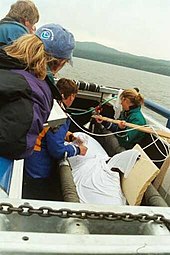
In 2002, the orphan Springer was successfully returned to her family.
Bigg's techniques also revealed the Pacific Northwest population was in the low hundreds rather than the thousands that had been previously assumed.[156] The southern resident community alone had lost 48 of its members to captivity; by 1976, only 80 remained.[168] In the Pacific Northwest, the species that had unthinkingly been targeted became a cultural icon within a few decades.[136]
The public's growing appreciation also led to growing opposition to whale–keeping in aquaria. Only one whale has been taken in North American waters since 1976. In recent years, the extent of the public's interest in killer whales has manifested itself in several high-profile efforts surrounding individuals. Following the success of the 1993 film Free Willy, the movie's captive star Keiko was returned to the coast of his native Iceland. The director of the International Marine Mammal Project for the Earth Island Institute, David Phillips, led the efforts to return Keiko to the Iceland waters.[169] In 2002 the orphan Springer was discovered in Puget Sound, Washington. She became the first whale to be successfully reintegrated into a wild pod after human intervention, crystallizing decades of research into the vocal behavior and social structure of the region's killer whales.[170] The saving of Springer raised hopes that another young killer whale named Luna, which had become separated from his pod, could be returned to it. However, his case was marked by controversy about whether and how to intervene, and in 2006, Luna was killed by a boat propeller.[171]
Whaling

The killer whale named Old Tom
swims alongside a whaling boat, flanking a whale calf. The boat is
being towed by a harpooned whale (not visible here), near Eden,
Australia.
Killer whales have helped humans hunting other whales.[174] One well-known example was in Eden, Australia, including the male known as Old Tom. Whalers more often considered them a nuisance, however, as they would gather to scavenge meat from the whalers' catch.[174] Some populations, such as in Alaska's Prince William Sound, may have been reduced significantly by whalers shooting them in retaliation.[17]
Captivity
Main article: Captive killer whales
The killer whale's intelligence,
trainability, striking appearance, playfulness in captivity and sheer
size have made it a popular exhibit at aquaria and aquatic theme parks.[175]
From 1976 to 1997, 55 whales were taken from the wild in Iceland, 19
from Japan, and three from Argentina. These figures exclude animals that
died during capture.[175]
Live captures fell dramatically in the 1990s, and by 1999, about 40% of
the 48 animals on display in the world were captive-born.[175]Organizations such as the World Society for the Protection of Animals and the Whale and Dolphin Conservation Society campaign against the practice of keeping them in captivity. In captivity, they often develop pathologies, such as the dorsal fin collapse seen in 60–90% of captive males. Captives have vastly reduced life expectancies, on average only living into their 20s.[Note 3] In the wild, females which survive infancy live 50 years on average, and up to 70–80 years in rare cases. Wild males who survive infancy live 30 years on average, and up to 50–60 years.[176] Captivity usually bears little resemblance to wild habitat, and captive whales' social groups are foreign to those found in the wild. Critics claim captive life is stressful due to these factors and the requirement to perform circus tricks that are not part of wild killer whale behavior.[177] Wild killer whales travel up to 160 kilometres (100 mi) each day, and critics say the animals are too big and intelligent to be suitable for captivity.[127]
In a 2011 CNN Justice news article, Bill Mears and Tom Cohen wrote about a lawsuit that PETA (People for the Ethical Treatment of Animals) pursued against SeaWorld. PETA filed a "20-page complaint [which] asks the U.S. District Court in Southern California to declare that the five whales – Tilikum, Katina, Corky, Kasatka, and Ulises – are being held in slavery or involuntary servitude in violation of the 13th Amendment."[178] PETA claims the 13th amendment technically does not state it applies only to human animals.[178] Ric O'Barry and two former SeaWorld trainers supported PETA in moving forward with this lawsuit.[178] Legal cases in state and federal courts dealing with animal cruelty tend to be based on human actions solely because animals cannot actually be prosecuted or actively participate as plaintiffs and defendants on trial.
In 1970, a killer whale, later named Lolita, was captured from the Puget Sound waters, and has since been performing at Miami Seaqurium for more than 40 years. During these four decades, celebrities, children, and a Washington governor have campaigned to free Lolita.[179] One of the Lolita supporters is Howard Garret, a cofounder of the nonprofit Orca Network located on Whidbey Island, Wash.[179] Garret believes Lolita has a strong memory of her life and her family in her former natural habitat. The Miami Seaquarium argues Lolita's interaction and dependence on her human caregivers supersedes her natural survival instincts, thus she would not survive on her own in the wild.[179] They also argue human and boat activity, as well as pollution, are serious threats to killer whales. In December 2011, supporters offered $1 million[179] to have Lolita freed from the Miami Seaquarium. After campaign and financial efforts to free Lolita were denied by the Miami Seaquarium, activists are suing the federal government in federal court in Seattle with the argument that Lolita should have been protected when other southern region orcas were listed as endangered species in 2005.[179] The Endangered Species Act (ESA) deems it illegal to "harass, harm, pursue, shoot, wound, kill, trap, capture, or collect" to any species put on the list.[180] The Miami Sequarium did not wish to comment on the lawsuit, instead it released a statement highlighting Lolita's life in captivity as active, healthy, and well cared for.[179] One plaintiff in the lawsuit, Carter Dillard, chief counsel for the Animal Legal Defense Fund, suggested Lolita should be moved to a larger "sea pen" home, where she would be able to swim farther distances and interact with other killer whales.[180]
In February 2010, 40-year-old SeaWorld Trainer Dawn Brancheau was killed by a 12,300-lb male[169] killer whale named Tilikum. The fatal event occurred after a show called "Dine with Shamu" at SeaWorld's Shamu Stadium in Orlando, Florida. The Orange County sheriff's spokesman Jim Solomons stated Brancheau slipped and fell into the 35-foot-deep tank, where one of the killer whales fatally injured her.[181] However, other witnesses maintain Brancheau was violently grabbed and attacked by the killer whale. Lori Miller, who attended the show at SeaWorld prior to the death of the trainer, spoke on "Larry King Live", saying the trainers had a hard time getting the killer whales to perform.[181] Captives occasionally act aggressively towards themselves, their tankmates, or humans, which critics say is a result of stress.[161] A spokesperson for PETA commented on this incident and referred to it as "a tragedy that didn't have to happen."[181] Before Brancheau's death, two other trainers were involved in incidents with killer whales at SeaWorld. In 2006 during a show at the Shamu Stadium, a trainer was seriously injured after being grabbed by a whale and held underwater.[181] In 1999, Daniel Dukes, age 27, sneaked into the park after closing, and his body was later discovered on Tilikum's back.[182] An examination of the body found multiple wounds, contusions, and abrasions. The coroner determined that the man had died from drowning and hypothermia.[183][184]
See also
- Iceberg (orca)
- List of cetaceans - whale and dolphin species
- List of whale vocalizations
- Marine biology




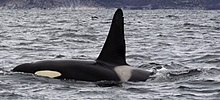
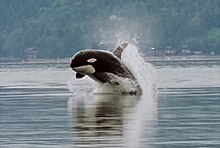
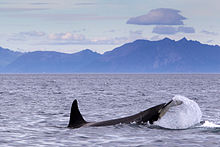
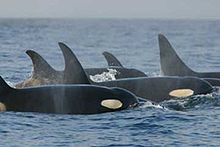


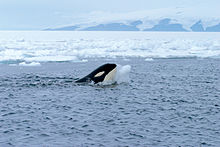

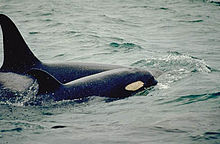


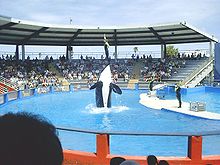
No comments:
Post a Comment